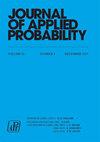老化概念、随机顺序和预期效用
IF 0.7
4区 数学
Q3 STATISTICS & PROBABILITY
引用次数: 0
摘要
老化概念、随机顺序和期望效用之间存在一些联系。已知DRHR(递减逆向风险率)老化概念可以通过风险厌恶的比较静态结果来表征,并且与位置无关的风险顺序保持风险溢价和风险厌恶的Arrow-Pratt度量之间的单调性,并且对于更大类别的增加效用,分散顺序保持这种单调性。在这里,老化概念ILR(增加似然比)、IFR(增加故障率)、IGLR(增加广义似然比)和IGFR(增加广义故障率)是根据预期效用来表征的。在此基础上,我们恢复了卷积下ILR、IFR和DRHR以及乘积下IGLR和IGFR的闭包性质,并研究了卷积下色散阶、位置无关风险阶、过剩财富阶、测试变换阶总时间和乘积下星形阶的闭包性质。我们有一些新的发现。本文章由计算机程序翻译,如有差异,请以英文原文为准。
Aging notions, stochastic orders, and expected utilities
Abstract There are some connections between aging notions, stochastic orders, and expected utilities. It is known that the DRHR (decreasing reversed hazard rate) aging notion can be characterized via the comparative statics result of risk aversion, and that the location-independent riskier order preserves monotonicity between risk premium and the Arrow–Pratt measure of risk aversion, and that the dispersive order preserves this monotonicity for the larger class of increasing utilities. Here, the aging notions ILR (increasing likelihood ratio), IFR (increasing failure rate), IGLR (increasing generalized likelihood ratio), and IGFR (increasing generalized failure rate) are characterized in terms of expected utilities. Based on these observations, we recover the closure properties of ILR, IFR, and DRHR under convolution, and of IGLR and IGFR under product, and investigate the closure properties of the dispersive order, location-independent riskier order, excess wealth order, the total time on test transform order under convolution, and the star order under product. We have some new findings.
求助全文
通过发布文献求助,成功后即可免费获取论文全文。
去求助
来源期刊

Journal of Applied Probability
数学-统计学与概率论
CiteScore
1.50
自引率
10.00%
发文量
92
审稿时长
6-12 weeks
期刊介绍:
Journal of Applied Probability is the oldest journal devoted to the publication of research in the field of applied probability. It is an international journal published by the Applied Probability Trust, and it serves as a companion publication to the Advances in Applied Probability. Its wide audience includes leading researchers across the entire spectrum of applied probability, including biosciences applications, operations research, telecommunications, computer science, engineering, epidemiology, financial mathematics, the physical and social sciences, and any field where stochastic modeling is used.
A submission to Applied Probability represents a submission that may, at the Editor-in-Chief’s discretion, appear in either the Journal of Applied Probability or the Advances in Applied Probability. Typically, shorter papers appear in the Journal, with longer contributions appearing in the Advances.
 求助内容:
求助内容: 应助结果提醒方式:
应助结果提醒方式:


